This life cycle assessment study investigates the environmental performance of sheep-based agrivoltaic systems and concludes that agrivoltaic systems are superior to conventional ground-mounted PV systems because they have dual purposes and reduce the environmental impacts associated with producing food and electricity.
Tag Archive for: Solar Grazing
Written By: Alex Delworth, Clean Energy Policy Associate; Center for Rural Affairs
Just off the campus of Maharishi University in Fairfield Iowa, sits a 1.1-megawatt (MW) solar farm. Beneath the panels, a flock of sheep and their newborn lambs are grazing, while beginning rancher Emily Mauntel and her Australian Shepherd Ziggy stand back and admire their work.
Solar farms pose a considerable opportunity for multipurpose agricultural uses in rural spaces. Iowa has seen a rapid increase in solar project development the past two years. According to the Solar Energy Industries Association, the industry is expected to add another 1,304 MW—a 250% increase over current installed capacity—during the next five years. Depending on the type of technology installed, this could mean between 6,520 and 13,040 acres of land will be used for solar production. With proper local siting, these projects will be required to plant and maintain native vegetation underneath the panels. This increase in open pasture presents a unique opportunity to combine traditional land uses with renewable energy development, such as pollinator habitats or open grazing for livestock. An opportunity Emily has already begun benefiting from.
Originally from Michigan, Emily relocated to Fairfield to attend Maharishi International University. While completing a three-month internship at a goat farm in Oregon as part of the university’s Regenerative Organic Agriculture certificate program, her interest in livestock grew. After the internship, she remained in Oregon for another year, working for various livestock operations and gaining experience in the industry. In late 2021, she moved back to Fairfield to work on the university’s vegetable farm and help her peers in their respective livestock businesses.
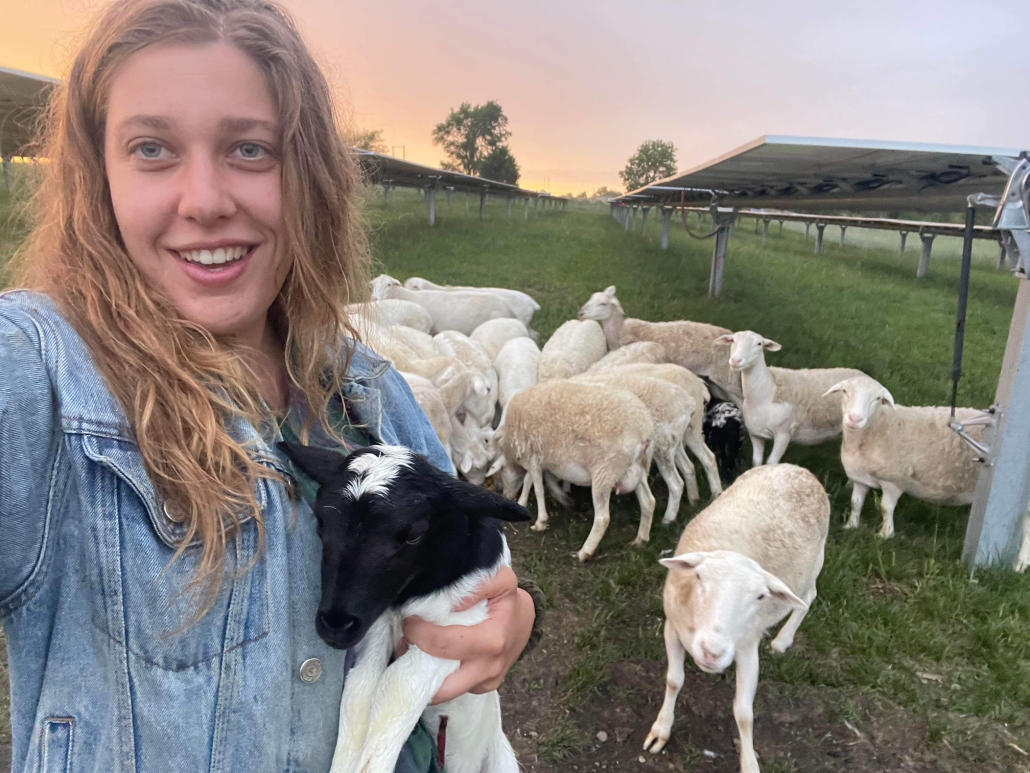
One day she and a friend were driving past a large solar array in Minnesota and noticed how the infrastructure was perfect for sheep grazing. They knew about the array in Fairfield, which is owned by the university and operated by Ideal Energy, a local solar company. She contacted the solar company to pitch the idea first and gained their approval before approaching the university. Both parties were ecstatic because the university had been looking for somebody to graze livestock and Ideal Energy saw an opportunity to avoid spending about $5,000 for annual landscaping, according to the company. Emily said the two parties came to an agreement that she would graze the array, which provided her an opportunity to access pasture in exchange for landscaping the solar farm. With this agreement, Emily benefited by not having lease payments for the time her sheep were on the farm, saving her approximately $360 per month according to Iowa State University’s land lease estimates, or about $2,520 for 2022.
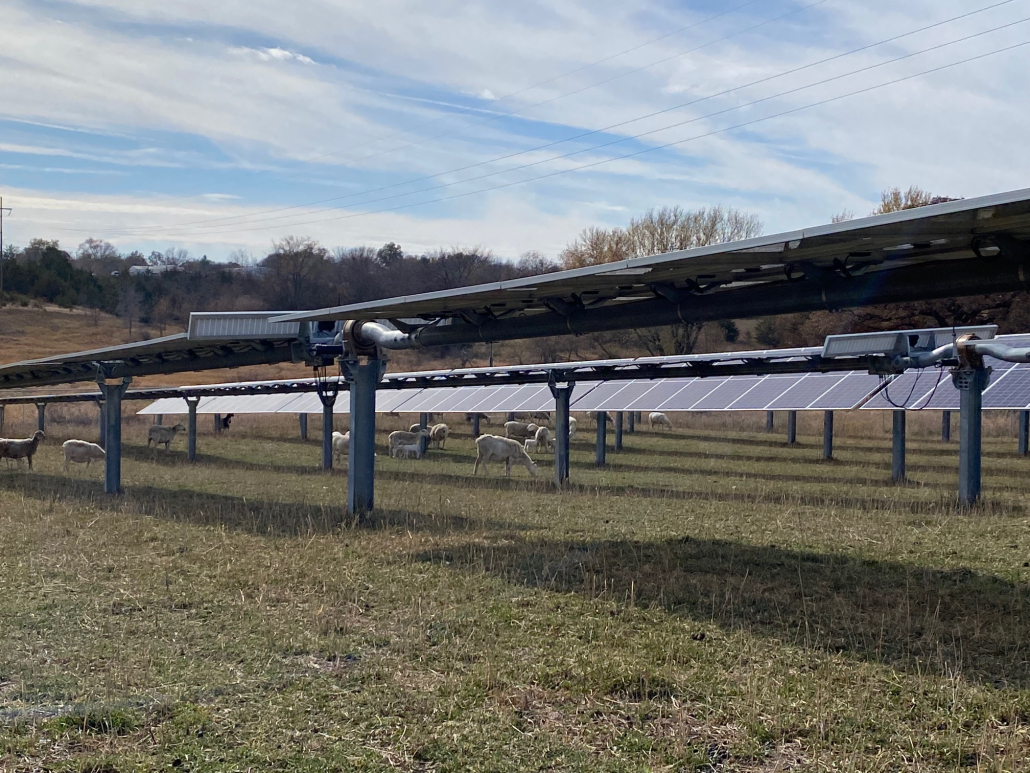
Once Emily had approval, she and her friend went into business together and purchased a 30-head herd of sheep from an auction in Texas. In May 2022, 29 ewes and one ram were dropped off on the six-acre, 1.1-MW solar farm. Before purchasing the herd, she surveyed the land and determined that, given the amount of growth on the site, she would be able to graze five sheep per acre. That is two more than usual because of how lush the plant life was on the property. The site was planted with a mix of flowering prairie species, including clover, fescue, broad-leaf plantain, and others, which served as a good food source. The sheep were allowed to roam freely throughout the solar array, something Emily said worked well. Overall, she believes rotational grazing would have been more efficient but would have required a larger investment due to the cost of a moveable fence.
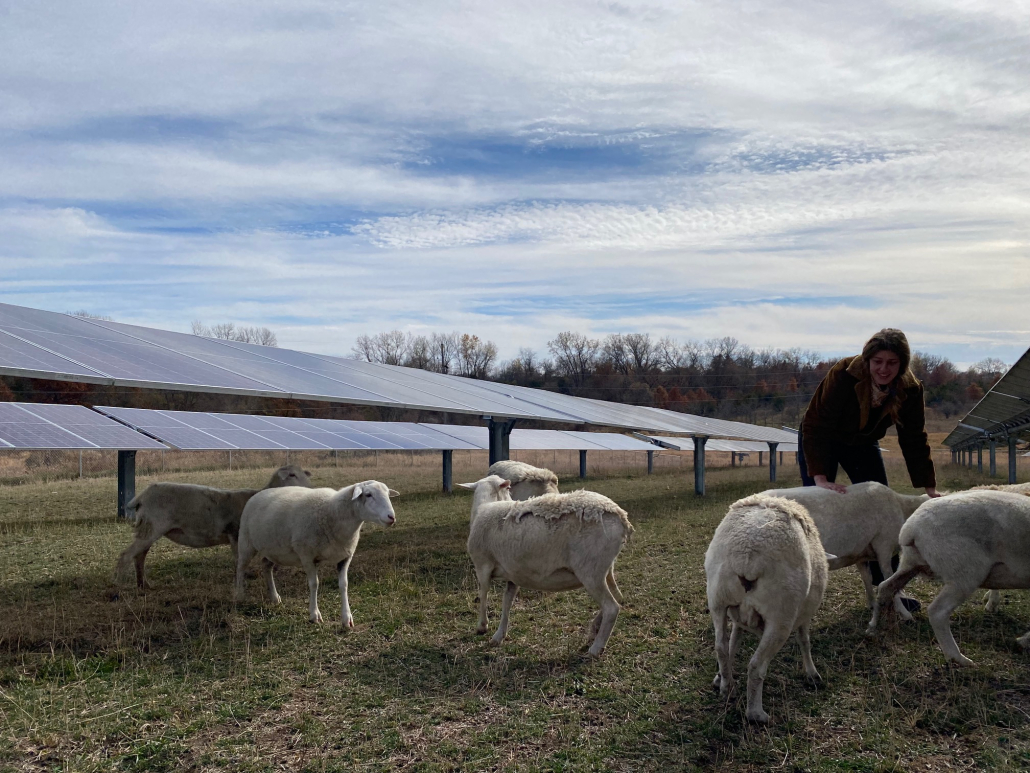
What makes this story especially interesting is that the agribusiness model directly addresses two major issues beginning farmers face—access to land and infrastructure. A 2017 survey by the National Young Farmers Coalition found that land access was the number one issue their respondents faced. Young farmers, according to the survey, are also the most inclined to rent, which makes finding land with the right infrastructure more difficult.
The Fairfield solar site’s infrastructure made the land even more attractive to Emily. She said it had sufficient fencing to hold her sheep and keep out predators. Due to the required native vegetation management, it also had plenty of food for the sheep, which means she never had to supplement food for them, except a mineral feed mix for nutrition. A water source to fill up the livestock troughs and an access road straight up to the gate also proved beneficial. Considering all of these factors, Emily was able to cut a lot of costs throughout the process.
Newly energized by the experience she has gained through solar grazers and managing her own livestock, Emily is now looking to return to the West to continue ranching. She and her business partner plan to sell their herd. Emily hopes to see the solar grazing model continue on the site, saying it has been a perfect opportunity for her to gain experience in the industry, and she believes it will be a great opportunity for the next person, as well.
DOE Solar Energy Technologies Office Announces $8 Million in Projects for Agrivoltaics Research
“The U.S. Department of Energy (DOE) Solar Energy Technologies Office announced $8 million in new projects that will research agrivoltaics—agricultural production, such as crop production, livestock grazing, and pollinator habitat underneath solar panels and/or in between rows of solar panels.
The Foundational Agrivoltaic Research for Megawatt Scale (FARMS) funding program will advance agrivoltaics practices and show how it can provide new economic opportunities to farmers, rural communities, and the solar industry. They explore different ways to implement agrivoltaics that will address concerns from the solar industry and farmers. Currently, less than 2% of solar systems utilize agrivoltaic practices.” – Energy.gov
AgriSolar Clearinghouse partner Greg-Barren Gafford from The University of Arizona is among the award recipients. Learn more about award recipients, which also include Rutgers and Ohio State University, here.
USDA Announces Climate Smart Commodity Awards
USDA Announced 71 climate-smart commodity awards in round 2 of the initiative. Among the awardees is The University of Texas Rio Grande Valley (UT-RGV), with the project “Validating Agrivoltaic Technology with Underserved Agricultural Producers.”
The AgriSolar Clearinghouse will serve as a technical assistance provider for this project. This work will include the production of outreach materials, education, and workshops to promote benefits to potential agrivoltaic adopters in the Rio Grande Valley.
JUA Technologies Develops Solar-Powered Dehydrator
“JUA Technologies, an agriculture technology start-up that manufactures solar-powered crop dehydrators, has received a two-year, $600,000 Phase II Small Business Innovation Research (SBIR) grant from the U.S. Department of Agriculture (USDA) to develop its technology.” – PV Magazine
Italian Research Shows Benefits of Growing Soybeans Using Agrivoltaics
“Scientists from Università Cattolica del Sacro Cuore in Italy have investigated different shade depth treatments on soybeans grown under an elevated agrivoltaic system in Monticelli d’Ongina, Italy. ‘Our work confirmed that soybean is shade tolerant and can be grown in combination with solar power generation. Considering not only soy but more crops and extensive crops in a large scale agrivoltaics is useful for increasing the sustainability of the agrivoltaic system itself.’ researcher Eleonora Potenza told PV magazine. – PV Magazine
Meta Obtains 720MW of Solar from Silicon Ranch
“Facebook owner Meta Platforms will power additional data center operations around the Southeast with 720 MW of new solar developments in Georgia and Tennessee with Silicon Ranch. Silicon Ranch is partnering with the Walton Electric Membership Corporation and the Tennessee Valley Authority (TVA) to supply power from seven new solar facilities to power Meta’s data centers in the two Southeast states, respectively.” – PV Magazine
Emma W. Kampherbeek, Laura E. Webb, Beth J. Reynolds, Seeta A. Sistla,
Marc R. Horney, Raimon Ripoll-Bosch, Jason P. Dubowsky, Zachary D. McFarlane
A study led by Emma Kampherbeek (Wageningen University & Research, the Netherlands) highlights multiple benefits of coupling solar energy production to sheep grazing in rangeland systems. This project investigated how sheep use solar arrays as a forage site and the impacts of solar array presence on forage quality in a California Central Coast site with a Mediterranean climate. Sheep with access to solar panels graze more than when they are on nearby native rangeland without an array. This increased foraging behavior is likely driven by a combination of the protection that the array provides the sheep from weather conditions, which increases grazing time, as well as increased protein content and digestibility of forage with the array footprint.
For this November teatime, we were excited to have Tyler Swanson and Jessica Guarino from the University of Illinois join us to discuss the latest on agrivoltaic regulations (check out their discussion of zoning, for example), solar grazing contracts, the economic considerations around grazing, and best practices from the targeted grazing industry that solar graziers can use for insight when developing contractual agreements. Much of the discussion revolved around issues concerning farmland becoming solar sites and the local conflicts that can create.
We had a very interesting discussion during the Q&A, where graziers dug into issues surrounding scaling up solar grazing, expanding agrivoltaics into crop production, and optimizing land-use for grazing at solar sites.
This Teatime was hosted by Kevin Richardson of the American Solar Grazing Association and Dr. Stacie Peterson of the AgriSolar Clearinghouse.
In November, Sabrina Portner from the University of Minnesota presented on her exciting research into growing 14 different forage and grain crops at three different solar sites. The forages and grain were grown in the context of feeding them to the research farm dairy herd. Sabrina and her team looked at how different shade levels affected each crop’s biomass production, as well as the nutritional value of the crops.
This research addresses an important issue: as land availability pressures increase, especially with the expansion of solar in rural areas, the sustainable intensification of agriculture and the need for combining solar sites with agricultural production become more imperative. Their research works towards both goals of food production and clean energy production while providing flexible economic opportunities to farmers.
This Teatime was hosted by Kevin Richardson of the American Solar Grazing Association and Victorian Smart of the AgriSolar Clearinghouse.
Farmers in France are Beginning to Combine Solar Panels and Crops
“In the Haute-Saône region, in the northeastern part of the country, an experiment is being conducted by solar-energy company TSE. It is hoping to find out whether solar energy can be generated without hindering large-scale cereal crops. Previous attempts to experiment with agrivoltaics have been through smaller-scale projects. But, keen to see if it can thrive on an industrial level, 5,500 solar panels are being spread over this farm in the commune town of Amance by TSE.” – Euronews
Solar Grazing Event Helps Kentucky Students Learn about Agrisolar
“The event was made possible through a partnership between the Kentucky Sheep and Goat Development Office, LG&E/KU, University of Kentucky, Ohio State University, and solar development company Lightsource bp. Students learned about solar technology, seed mix establishment and meeting nutritional needs in solar grazing. Additionally, the release said students were able to tour the LG&E/KU E.W. Brown Generating Station’s solar array in Mercer County.” – The News Enterprise
Cornell Researcher Hosts EarthTalks Agrisolar Series
“Niko Kochendoerfer, a postdoctoral fellow in animal sciences at Cornell University, will deliver the talk ‘Effect of sheep stocking rate on ecosystem parameters in ground-mounted solar arrays’ at 4 p.m. on Monday, Nov. 14. The talk, which is free and open to the public, takes place in 112 Walker Building on the University Park campus and via Zoom.” – PSU
Rebecca A. Efroymson, Environmental Scientist, Oak Ridge National Laboratory); and Jonathan M. O. Scurlock, Chief Adviser for Renewable Energy & Climate Change, National Farmers’ Union of England and Wales
Solar photovoltaic (PV) power, the most popular form of renewable energy on farms, is being adopted all over the world. Growers and processors of food worldwide have a long history of using the sun’s energy to produce and dry their crops, and solar PV is adding a modern twist to our relationship with the sun. It is no surprise that some of the best locations on Earth for harnessing solar energy are often ideal places for agriculture and horticulture. However, intelligent design for multi-purpose land use can alleviate real or perceived conflicts between energy and food production. Solar modules can shade crops where light intensity is in excess of crop requirements, reducing water evaporation; they can be mounted on agricultural buildings to power farm business energy needs; and they can export low-carbon electricity to meet wider demands for “green” power and the transition to a “net zero” global economy.
We use the term agrivoltaics broadly to describe any combination of agricultural activity and solar electricity production, but outside the USA, the term usually refers more specifically to the intimate juxtaposition of solar modules and agricultural land use. Examples include PV modules mounted at a height of several meters to allow access to land below by farm machinery or large livestock, where they provide shelter from storms or excessive solar radiation, and the integration of solar PV into greenhouses for crop protection.
We caught up with a range of projects across three continents to report upon their objectives and their future prospects.
Around 30% of British farmers have either rooftop or ground-mounted solar energy. The National Farmers Union (NFU) aspires to the goal that every farmer and grower have the opportunity to become a net exporter of low-carbon energy. The falling capital cost of both solar and battery electricity storage has resulted in a growing pipeline of solar installations across a range of sizes, including large 100-hectare (ha) and 1,000-ha solar farm projects, largely independent of government policy support. The NFU advises farmers that solar PV can be deployed across entire fields, as small, ground-mounted installations around field margins or adjacent to farmyards, on farm buildings, and on domestic rooftops. Developers of solar farms are encouraged by the NFU to follow best practice guidelines for multi-purpose land use, combining energy production, continued agricultural management such as grazing, and creation of wildlife habitat. NFU’s strong preference is for large-scale solar farm development to be located on lower-quality agricultural land, avoiding as much as possible the most productive and versatile soils. Roof-mounted solar systems in Britain continue to offer a sound investment, making between 10% and 25% simple return on capital annually at current electricity prices, depending on how much of the generated power is used on-site. At of the end of 2021, about 70% of the United Kingdom’s 14 gigawatts of solar power generation capacity was located in the agricultural sector.
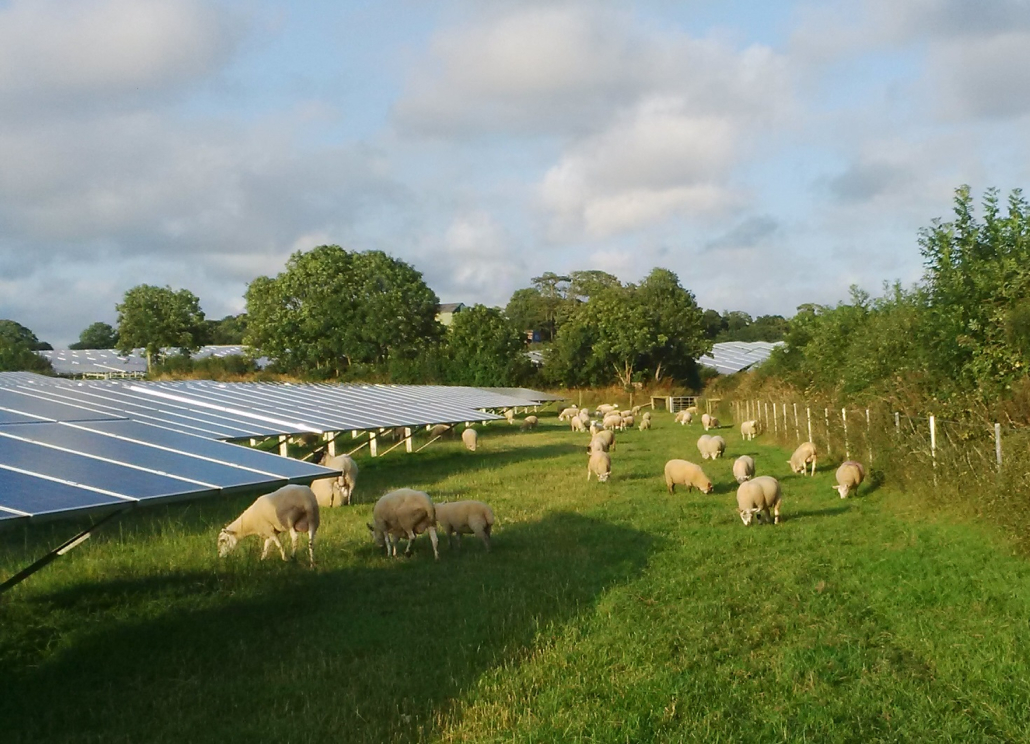
In the Netherlands, the Symbizon project at Almere, near Amsterdam, has brought together a Swedish energy company with Dutch researchers and a private organic farm to construct a 700-kilowatt solar park with alternating strips of PV modules and rows of crops. Starting in spring 2023, the production of herbs will be investigated, and potatoes, beans, beetroot, broccoli, and grains may be included in this pilot study. Pivoting double-sided (bifacial) solar modules will catch the reflected light from soil and crops.
Nearby in Germany, Goldbeck Solar is an innovator in solar agrivoltaic structures. The company has developed a system of solar PV arches that slide on side rails, allowing farmers to shelter or expose various crops. Typically oriented east to west for maximum solar energy yield, the arches span up to 9 meters, at a height of 2.5 to 3 meters, allowing a degree of control over temperature, humidity, and light. These agrivoltaic modules can also provide shelter for livestock from extreme weather, such as high temperatures and hail. The modules are currently undergoing trials in the four-year Sunbiose project in the Netherlands, which had already succeeded in growing raspberries under the partial shelter of solar PV modules.
Agrivoltaics are being tested in East Africa, where their shade can reduce heat stress and water loss, and farmer incomes in disadvantaged rural communities may be improved. An experimental facility opened in 2022 in Insinya, Kenya, through partnership with Universities of Sheffield, York and Teesside in the United Kingdom, the Stockholm Environment Institute, World Agroforestry, the Centre for Research in Energy and Energy Conservation, and the African Centre for Technology Studies. Some 180 PV modules, each 345 watts, have been installed about 3 meters above the ground, allowing a variety of crops to be grown under the shade from the strong equatorial sun. Geoffrey Kamadi of The Guardian reports that benefits include improved yields of cabbage, eggplant, and lettuce; a reduction in water loss; and a reduction in high daytime temperatures and UV damage.
Small-scale agrivoltaic development (less than 0.1 ha) has progressed rapidly in Japan, producing 0.8% of the total solar power generated in the country in 2019. Japan has perhaps the greatest number of agrivoltaic farms to date, with more than 120 plant species being cultivated on agrivoltaic farms. The Solarsharing Network provides a catalog of 27 agricultural crops (Solar Sharing for FUN | SOLAR SHARING NETWORK| Solar Sharing Association of Japan (solar-sharing.org) and their light needs. Innovative crop systems include tea, according to Makoto Tajima and Tetsunari Lida of the Institute for Sustainable Energy Policies.
One pilot agrivoltaic project in New Zealand is seeking low-growing flowering plants like alyssum to attract bees and reflect light up to rows of bifacial PV modules. The high energy demand of irrigation systems can benefit from on-farm solar energy. In New Zealand, as in the U.S., UK, and Australia, sheep and other small livestock graze under solar modules, avoiding the need for mowing. As New Zealand reporter Delwyn Dickey notes, the success of such large-scale agrivoltaic systems (i.e., solar farms) may be determined by an insistence upon dual land use during the consenting process and the willingness of solar energy development companies to adopt dual land use.
Clearly, from small-scale intimate mingling of solar PV with agricultural production to multi-purpose land use in the largest of solar farms, the merits of harvesting the sun’s energy twice are appreciated the world over. The outlook for agrivoltaics is bright indeed.
In partnership with Lightsource BP, Texas Solar Sheep grazes over 1,800 sheep on a solar site in Deport, Texas. These sheep are grazed in groups of 50 to 75, 250 to –270, and even 500, making Texas Solar Sheep one of the largest Agrisolar grazing operations in the United States.
All 1,800 sheep are grazed and managed on one solar site, which has 18 individual pastures. The sheep are grazed year-round on the same site. The area gets maybe one snowfall a year, which is not a huge issue for them, as the solar panels provide good protection from elements for the sheep. The farm may buy one stockpile of hay for the winter if they feel it is necessary as a precaution, but stockpiling food is not a great concern on this operation.
No mowing duties are required on this site, thanks to responsibly managed, rotational grazing of the sheep. There are many weeds that sheep will not eat, so they must be manually removed. After some time, if those weeds can be removed from the site, then there is no need for mowing or the use of gas or diesel-operated maintenance equipment. Graziers mowed this site four times in 2021 and have not mowed at all in 2022 as of the end of September.
J.R. Howard, owner of Texas Solar Sheep, says it is important for new graziers to know that the client of this operation is the solar site, and the grazier is providing a service to replace mowing on the site. The sheep-grazing service has been shown to provide significant benefits to the solar site, including enhancing the health of the turf, reducing runoff from rainfall, and providing crucial shade relief to both the grasses and the sheep during drought periods like those seen in 2021.
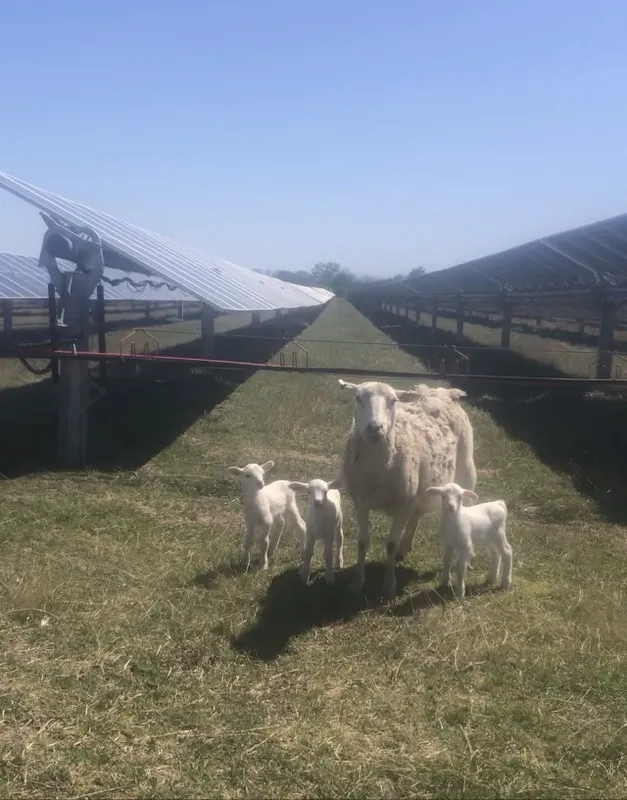
Healthy Turf Prevents Runoff
The site has realized benefits from preventing rainfall runoff as a result of developing healthy turf. There was hardly any runoff after 3 inches of rainfall, due to the enhancement in turf quality from responsible grazing management, according to Howard. Healthy turf is a result of not overgrazing individual areas and managing proper sheep rotation. The sheep are not allowed to eat to the bare ground, resulting in what is known as a healthy turf that allows the land to capture and hold the water when it rains, resulting in less runoff and other associated issues. Howard said the land is back to looking like “normal land” and not “golf courses.”
Shade Relief for Grasses and Sheep
During the drought of 2021, the solar panels provided crucial shading for the grasses and the sheep. The grass between the panels that did not have shade did not do as well as the grasses that were getting shade from the panels. “The shade support really helped a lot,” Howard said.
Sheep typically feed in the morning and then hang out in the shade during the day, which the panels provide plenty of. Unlike goats and cattle, sheep do not damage equipment by rubbing against it, climbing on it, or chewing on wires as some goats do. The sheep can be comfortable under the panels during the day with little, if any, threat of damage to equipment.
Rotational Fencing
One challenge that the operation has dealt with is constantly rotating the sheeps’ pasture, which needs to be consistent and on schedule. Limiting grazing to smaller areas more often, as opposed to one large area less frequently, is ideal. However, this approach requires fencing that must be moved regularly. The operation requires “cross fences” to break large blocks of land into smaller pastures. Moving fences is one of the most consistent tasks of the operation, but it is manageable.
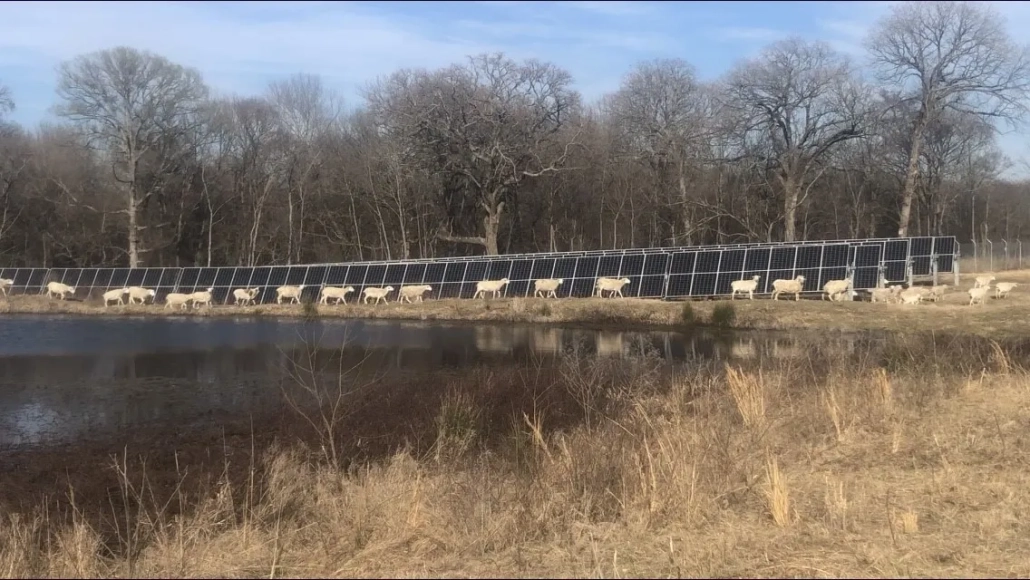
Breeding for Agrisolar Conditions
The solar company allows the sheep owners to breed lambs when they want. The sheep live on the solar site from birth until they are sold or pass away. The sheep are also checked by a veterinarian at various times during their life cycle on the site. Owners breed sheep on site, to “get the ewe they want,” Howard said.
This selective breeding process is an attempt to breed a sheep genetically superior in parasite resistance than previous generations of sheep. These sheep would be specifically resistant to parasites during the lamb phaseand the lactating ewe phases of their life, which are often when farmers struggle with parasites infecting their sheep. Due to the selective breeding process on this site, the sheep will be more resilient to the conditions they experience in Texas, which includes hot temperatures and prolonged, wet conditions.
Although Dorper sheep, which originated in South Africa, are genetically capable of handling hot temperatures, they are being breed with Katahdin and St. Croix to enhance their genetic capabilities further—making them the most ideal sheep for agrisolar operations in these climate conditions.

What New Graziers Should Know
New graziers should know that this is not a grazing lease with the solar company but, rather, a grazing service business. As a service business, people with sheep will have a customer that they are providing a service to. This requires graziers to spend more time on-site where they can correct issues quickly. If sheep get out of the fenced paddocks, graziers can get them back to their assigned areas quickly. Sometimes sheep pass away and need to be removed as quickly as possible. Being on-site allows for that. If sheep are sick, they can be attended to quickly. The grazier can also ensure that sheep have constant access to water.
The solar company also benefits from having Texas Solar Sheep staff on-site regularly. “We are out there more than the solar folks, so we see issues for them, too. It has been an extra set of eyes for them on the solar equipment, so that has been a significant help for them, as well. If they see downed panels, damaged wiring, or even fires, they can report it quickly and get it taken care of,” said Howard. “There is a public eye on this stuff, so we want to make sure we are doing it right.”
Howard stated that grazing is the future of utility-scale solar. It is important that the first few big sites get it right. With great partners like Lighthouse BP, Texas Solar Sheep has been able to scale up its operation, and is planning for larger sites for the future, meaning more sheep on more solar sites.
Howard said the family farm had about 300 ewes and having the opportunity to partner with Lightsource BP has allowed them to have extra land to graze and scale up their operation. “We’re not a big landowner, and this allowed us to scale up a lot, to 1,800 ewes.”
In August 2022, ASGA Board President Jonathan Barter and “The Grass Whisperer” Troy Bishopp joined us for a lively discussion on how to plan grazing management.
For their follow up, Jonathan and Troy led a discussion focused on planning for larger grazing operations. They invited graziers and ASGA members JR Howard, Josiah Fleury, and Dennis Bauman to discuss their experience with grazing operations on large sites. The conversation was wide-ranging and dug into the practical components of how you plan grazing at scale as well as regional differences, including between smaller-scale operations in the Northeast where utility-scale grazing is less common and Texas and other states where utility-scale grazing is more the norm.
Here are some of the broader topics they covered:
- Their roles in site design and layout
- Challenges they’ve encountered in developing management strategies
- Planning for economic considerations and contract compliance
- Water supply, mowing, and fees
Hosts: Kevin Richardson (ASGA) and Carl Berntsen from AgriSolar Clearinghouse / NCAT
This Teatime is part of a series co-hosted and sponsored by the AgriSolar Clearing House team. We thank them for their generous support and for adding their expertise to the Teatime events!
